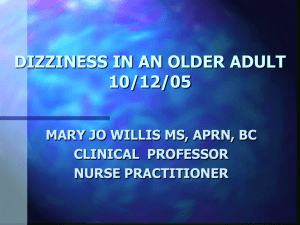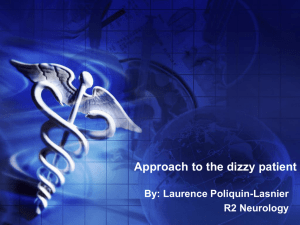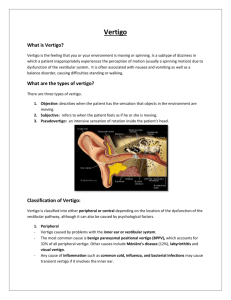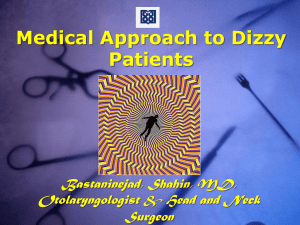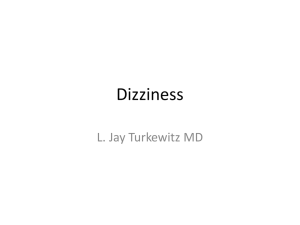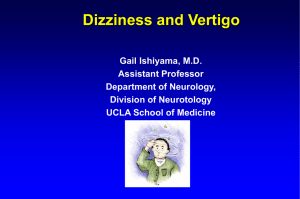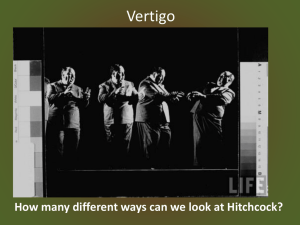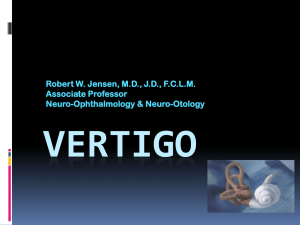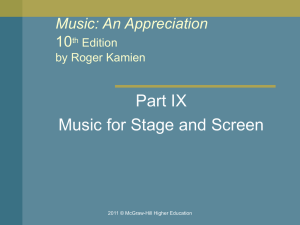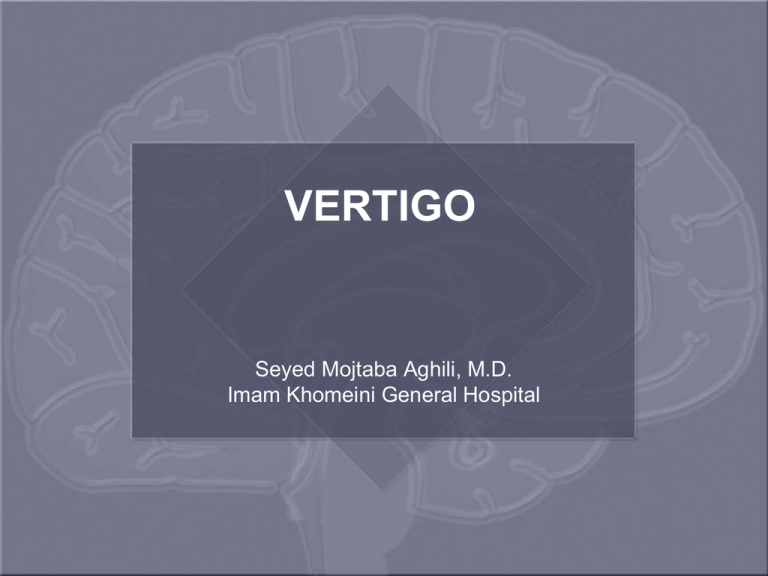
VERTIGO
Seyed Mojtaba Aghili, M.D.
Imam Khomeini General Hospital
Definition
• Dizziness may mean vertigo, syncope,
presyncope, weakness, giddiness, anxiety,
or a disturbance in mentation to various
patients.
• Vertigo is the perception of movement
(rotational or otherwise) where no movement
exists
Definition
• Syncope is a transient loss of consciousness
that is accompanied by loss of postural tone
with spontaneous recovery.
• Near-syncope is light-headedness with
concern for an impending loss of
consciousness
Pathophysiology
• visual, vestibular, and
proprioceptive systems
• Vertigo arises from a
mismatch of
information from two or
more of the involved
senses
PH/E
• The most striking clinical sign associated
with vertigo is nystagmus.
• Rhythmic movement of the eyes that has
both a fast and a slow component, with
direction named by its fast component.
• http://www.youtube.com/watch?v=oUlUVWQ
x7zI
• The fast component of nystagmus is caused
by the cortex
• The nystagmus of vestibular injury or
dysfunction is provoked when the affected
side is in the dependent position, and the
characteristic pattern is vertical and
rotational or horizontal.
• Vertical nystagmus by itself (and not
associated with a rotational component)
usually indicates a brainstem
abnormality.
• an atypical pattern of nystagmus in the
absence of other signs of CNS disease does
not necessarily indicate central pathology
Clinical Features
"peripheral" or "central"
• Peripheral vertigo is caused by disorders
affecting the vestibular apparatus and the
eighth cranial nerve
• Central vertigo is caused by disorders
affecting central structures, such as the
brainstem and the cerebellum
• severity and even accentuation with certain
head positions, while suggestive, does not
uniformly distinguish underlying pathology.
Etiologic Classification of Vertigo
• Vestibular/otologic
– Benign paroxysmal positional vertigo
– Traumatic: following head injury
– Infection: labyrinthitis, vestibular neuronitis, Ramsay
Hunt syndrome
• Syndrome
–
–
–
–
–
–
Ménière syndrome
Neoplastic
Vascular
Otosclerosis
Paget disease
Toxic or drug-induced: aminoglycosides
• Neurologic
–
–
–
–
–
–
–
–
–
–
–
Vertebrobasilar insufficiency
Lateral Wallenberg syndrome
Anterior inferior cerebellar artery syndrome
Neoplastic: cerebellopontine angle tumors
Cerebellar disorders: hemorrhage, degeneration
Basal ganglion diseases
Multiple sclerosis
Infections: neurosyphilis, tuberculosis
Epilepsy
Migraine headaches
Cerebrovascular disease
• General
– Hematologic: anemia, polycythemia,
hyperviscosity syndrome
– Toxic: alcohol
– Chronic renal failure
– Metabolic: thyroid disease, hypoglycemia
Peripheral vs Central Vertigo
•
•
•
•
•
•
•
•
•
•
•
Peripheral
Onset
Sudden
Severity of vertigo Intense spinning
Pattern
Paroxysmal, intermittent
Aggravated by position/movement Yes
Associated nausea/diaphoresis Frequent
Nystagmus Rotatory-vertical, horizontal
Fatigue of symptoms/signs Yes
Hearing loss/tinnitus May occur
Abnormal tympanic membrane May occur
Central nervous system symptoms/signs Absent
Central
Sudden or slow
Ill defined, less intense
Constant
Variable
Variable
Vertical
No
Does not occur
Does not occur
Usually present
Peripheral vs Central
• Peripheral vertigo: distressing symptoms,
seldom life-threatening.
• Central vertigo: less distressing symptoms,
slower onset than those due to peripheral
vertigo
Diagnosis
• The key: an unprompted description of the
patient's "dizziness."
• Avoid leading questions because they may
bias the patient's responses
Peripheral vs Central
• Peripheral vertigo: intense and associated
with nausea, vomiting, diaphoresis, tinnitus,
hearing loss, and photophobia
Peripheral vs Central
• Central vertigo: associated with neurologic
symptoms and signs such as diplopia,
dysarthria, and bilateral visual abnormalities.
• An associated headache or history of
headache: migraine, stroke, transient
ischemic attack (TIA), or a space-occupying
lesion.
?
• Clinician should not be reassured that a
central cause is not present when symptoms
appear more consistent with benign
peripheral etiology
Central Vertigo
– Older patients,
– those with hypertension or cardiovascular
disease,
– those with other risk factors for stroke, or
– those taking warfarin
should be evaluated for central vertigo.
Temporal Patterns Seen in Vertigo
Pattern
Conditions
Seconds
Benign paroxysmal positional vertigo,
postural hypotension
Minutes
Transient ischemic attacks
Hours
Ménière disease
Days
Viral labyrinthitis
Constant
Nonspecific dizziness
Physical Examination
• Ear, Neurologic, and Vestibular
examinations
• Insufflation of air by use of a pneumatic
otoscope that precipitates a burst of vertigo
with nystagmus is diagnostic of an inner ear
fistula
Central vertigo
• Central vertigo:
– check for an absent corneal reflex, facial
paresis, difficulty swallowing, dysphonia, and
depressed gag reflex.
– Limb and truncal ataxia, and test the
vestibulospinal system and cerebellum through
tandem gait and Romberg testing.
– Proprioception and vibration
Dix-Hallpike
• BPPV: Dx aided by the Dix-Hallpike
position test.
– This test should not be performed on patients
with carotid bruits, cerebrovascular disease, risk
factors or concern for vertebrobasilar
insufficiency (VBI), spinal injury, or cervical
spondylosis
Dix-Hallpike
• The patient should be cautioned that the test
could provoke vertigo. Pretreatment with 50
milligrams dimenhydrinate IM or IV may
make the test more tolerable but will not
obliterate nystagmus
Dix-Hallpike
• A positive test is indicated by rotatory
nystagmus following a latency of no more
than 30 seconds; the nystagmus exhibits
rapid eye torsions toward the affected ear
and lasts for 10 to 40 seconds
Dix-Hallpike
• The side exhibiting the positive test is the
side of the lesion. The test is about 50%
to 80% sensitive for BPPV.
• Benign paroxysmal positional vertigo is the
most common cause of vertigo
• visual, vestibular, and proprioceptive
systems, any disease that interrupts the
integration of these three systems
• slow movement of the eyes toward the side
of the stimulus, regardless of the direction of
deviation of the eyes.
• The cerebral cortex then corrects for these
eye movements and rapidly brings the eyes
back to the midline
• direction of nystagmus is denoted by the
direction of the fast "cortical" component.
• Nystagmus caused by vestibular disease:
unidirectional and horizontorotary.
• If the nystagmus is vertical, a central lesion
(either brainstem or cerebral)
Differential Considerations
• Patients use the term dizzy to describe a
variety of experiences,including sensations
of morion, weakness, fainting,
lightheadedness, unsteadiness, and
depression.
differential diagnosis of dizzy
1) dysrhythmias,
2) myocardial
infarction,
3) sepsis,
4) hypovolemia,
5) drug side effects,
and
6) PTE,
7) anemia,
8) viral illness,
9) depression
• cerebellar hemorrhage: immediate
therapeutic intervention
• Acute suppurative labyrinthitis is the only
cause of peripheral vertigo that requires
urgent intervention.
History
• Does true vertigo exist?
• The labyrinth has no effect on the level of
consciousness, patient should not have an
associated change in mentation or syncope.
• A sensation of imbalance often accompanied
vertigo, but true instabiliry, disequilibrium or
ataxia makes a higher likelihood of a central
process.
• time of onset and the duration of vertigo?
• Episodic vertigo that is severe, lasts several
hours, and has symptom-free intervals
between episodes suggests a peripheral
labyrinth disorder
• auditory symptoms?
• Are there association neurologic symptoms?
• recent head or neck trauma?
• isolated vertigo can be the only initial
symptom of cerebellar and other posterior
circulation bleeds, transient ischemic attacks
(TIAs), and infarction.
Imaging and admission
1)
2)
3)
4)
5)
6)
7)
8)
Older age,
male sex,
hypertension,
coronary artery disease,
diabetes mellitus, and
atrial fibrillation,
frequent episodes lasting only minutes or
prolonged episodes of a day or more
Past Medical History
• aminoglycosides, anticonvulsants, alcohols,
quinine, quinidine, and minocycline, caffeine
and nicotine
Physical Examination
• Pulses and blood pressure in both arms.
• R/o subclavian steal syndrome, which also
can cause vertebrobasilar artery
insufficiency
Physical Examination
• Carotid or vertebral artery bruits?
• impacted cerumen or a foreign object in the
ear canal?
• Examination of the eyes?
Internuclear ophthalmoplegia
• Internuclear ophthalmoplegia:
– eyes are in a normal position on straight-ahead
gaze, but on eye movement the adducting eye
(cranial nerve III) is weak or shows no
movement while the abducting eye (cranial
nerve VI) moves normally, although ofren
displaying a coarse nystagmus.
Internuclear ophthalmoplegia
• interruption of the medial longitudinal
fasciculus on the side of the third cranial
nerve weakness: brainstem pathology and
virtually pathognomonic of multiple sclerosis.
Positional testing
• Hallpike maneuver, the patient is moved
quickly from an upright seated position to a
supine position, and the head is turned to
one side and extended (to a headdown
posture) approximately 30' from the
horizontal plane off the end of the stretcher.
• repeated with the head turned to the other
side, indicates vestibular pathology on that
same side.
Positional testing
Nystagmus?
Neurologic examination
• cranial nerve deficits suggests a spaceoccupying lesion in the brainstem or
cerebellopontine angle
• corneal reflex, hearing loss, evidence of
cerebellar dysfunction?
• In supranuclear facial paralysis, the forehead
is spared because these muscles receive
bilateral cortical innervation.
Neurologic examination
• Dysmetria is the inability ro arrest a muscular
movement at the desired point.
• Dysmetria should be assessed using fingerto-finger/finger-to-nose pointing
• dysdiadochokinesia(an inability to perform
coordinated muscular movement smoothly)
is assessed with rapid alternating
movements.
Neurologic examination
• Any marked abnormality (e.g., consistent
falling or a grossly abnormal gait) should
suggest a central lesion, especially in a
patient whose vertiginous symptoms have
subsided.
Ancillary testing
• A finger-stick blood glucose
• Blood counts and blood chemistries
• An electrocardiogram
Radiologic imaging
• cerebellar hemorrhage, cerebellar infarction,
or other central lesions: emergent computed
tomography (CT) or magnetic resonance
imaging (MRI) of the brain
• MRI, has become the diagnostic modality of
choice when cerebellar processes other than
acute hemorrhage
Radiologic imaging
• many studies strongly support the use of
imaging in patients of advanced age or at
risk for cerebrovascular disease.
Diagnostic Algorithm
MANAGEMENT
• Any suggestion of cerebellar hemorrhage
should warrant immediate imaging with CT
or MRI and neurosurgery consultations.
• VBI should be considered in any patient of
advanced age or at high risk of
cerebrovascular disease with isolated, newonset vertigo without an obvious cause.
• Because of the possibility of progression of
new-onset VBI in the first 24 to 72 hours,
hospital or observation unit admission and
considering early magnetic resonance
angiography.
• Changing or rapidly progressive symptoms
should raise awareness of impending
posterior circulation occlusion.
• If CT or MRI excludes hemorrhage as the
source of the patient's symptoms, an
immediate neurologic consultation,
emergency angiography, and possibly
anticoagulation are indicated.
• Acute bacterial labyrinthitis requires
admission, intravenous antibiotics, and
occasionally surgical drainage and
debridement.
• Meniere's disease have been treated
successfully by vasodilation and diuretic
therapy, diets low in sodium and caffeine
and cessation of smoking
• Chemical ablation of vestibular function with
gentamicin and streptomycin is an option in
severe Meniere's disease
• The treatment of acute attacks of vertigo
caused by peripheral disorders is
symptomatic.
• Intravenous diazepam in 2- to 5-mg doses is
extremely effective in stopping vertigo.
• Outpatient treatment with diazepam can be
continued at doses of 5 to 10 mg three times
daily.
• Anticholinergic drugs or antihistamines with
anticholinergic activity are extremely useful
in treating vertigo.
• Meclizine hydrochloride (Antivert) is usually
prescribed as 25 mg every 8 hours
• Diphenhydramine hydrochloride (Benadryl),
25 to 50 mg every 6 to 8 hours, and
dimenhydrinate.
• Promethazine hydrochloride (Phenergan), 25
mg orally or rectally every 6 to 8 hours, is
effective because of its strong antiemetic
and mild anticholinergic properties; it also
can be used intravenously in doses of 12.5
to 25 mg
• Avoidance of stimulants (e.g., caffeine,
pseudoephedrine, Nicotine)
• canalith repositioning procedures, such as
the Epley and Semont maneuvers in BPPV.
• The Epley maneuver involves sequential
movement of the head into four positions,
staying in each position for approximately 30
seconds.
• One of the most useful tools the physician
has is patient reassurance.
Management algorithm for vertigo
Epley
DISPOSITION
• Documented or suggested cerebellar
hemorrhage or infarction, VBI, and acute
bacterial labyrinthitis require workup and
hospitalization.
• In patients older than age 55 years,
particularly patients with vascular disease,
admission for observation and imaging of
cerebral vasculature is often warranted
• Some patients may have such severe
symptoms (e.g., vomiting, inability to walk)
despite a trial of medication that they require
admission for intravenous hydration and
observation.
• All discharged patients should receive
primary care; neurology; or a follow-up
consult with an ear, nose, and throat
specialist.



